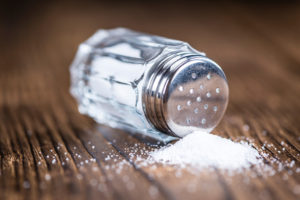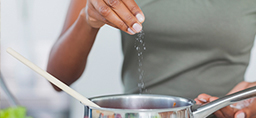
Most Americans eat way too much salt—and they probably don’t even know it.
How much are you supposed to eat? Less than 2,300 milligrams a day, according to the Dietary Guidelines for Americans.
For people with cardiovascular or kidney disease, that number drops to 1,500 milligrams a day, which is also the American Heart Association’s ideal limit.
But how much sodium does the average American consume in a day? About 3,400 milligrams.
“Most of us are taking in too much,” said Holly Dykstra, a registered dietitian with Spectrum Health Cardiovascular Medicine. “The average person can probably stand to lower their sodium intake to some extent.”
Where is all this sodium we eat coming from? Why is it bad for us? And what can we do to limit it?
Dykstra has answers.
Why do we need sodium? When is it too much?
We need some sodium every day. It helps maintain the right balance of fluids in the body and it’s important in nerve and muscle function. Our kidneys work to naturally balance the amount of sodium stored in our bodies.
If there’s more sodium than your kidneys can eliminate, it builds up in your blood.
“In our bodies, salt and fluids hug each other to maintain a balance,” Dykstra said. “The problem is that when we eat more salt, we retain more fluid to maintain that balance. And for a lot of people, this can be concerning.”
If you have high blood pressure, heart failure or kidney disease, the extra fluid causes problems because it makes your heart and kidneys work harder to do their job, Dykstra said.
This puts a strain on those organs.
“The research shows that those populations can benefit from lower sodium intake,” Dykstra said.
Eating more than 2,000 milligrams of sodium a day can cause us to retain an extra gallon of fluid in our bodies, which is about 8 pounds, she said.
To put that in perspective, a teaspoon of salt is approximately 2,300 milligrams of sodium.
How much sodium am I eating?
One way to find out how much sodium you’re getting is to read nutritional labels.
First look at the top of the label, at the serving size. Many of the packaged foods we eat have more than one serving in a single container, Dykstra said. It’s important to compare what you are eating to the serving size.
Then look on the left side of the label for the amount of sodium in milligrams. Your total sodium consumption should be less than 2,300 milligrams each day, or lower if you have some of the previously mentioned conditions.
You can also look on the right side of the label for the percent daily value, which is based on a general 2,000-calorie diet. Dykstra notes that if one serving contains 20% of more sodium, it is likely a high sodium food.
Also beware of sodium sources on labels that might not explicitly say sodium, such as monosodium glutamate.
What are some high sources of sodium?
Believe it or not, only about 10% of the sodium we eat every day comes from salt we add during home cooking or at the table, according to the American Heart Association. About 70% of our salt intake comes from pre-packaged, processed foods and restaurant meals.
The foods highest in sodium are the well-known culprits, such as canned soups, frozen foods, chips, pizza, cold cuts, bacon, hot dogs, soy sauce, boxed macaroni and cheese, pre-packaged meals and sides.
But Dykstra said people are often surprised to learn the amount of sodium in bread, cheese, milk, salad dressings and electrolyte replacement drinks like Gatorade.
“When we look at foods that probably should spoil, but they haven’t, that’s where it’s surprising,” she said. “We’re so used to modern ways of preserving food, and bread having a long shelf life.”
What can I do to reduce sodium in my diet?
Dykstra’s No. 1 recommendation? Try to eat mostly nutrient-dense, whole, fresh foods—foods that have not been processed or refined.
This includes fruits, vegetables, nuts, seeds, whole grains, meat, fish and eggs.
“If you’re eating a diet with whole foods or only minimally processed foods, you’ll most likely get all the sodium your body needs to function normally,” she said. “You will also be eating lots of other important nutrients for your body to thrive.”
When buying processed foods, read the labels to monitor your sodium intake.
Also try to limit your consumption of restaurant food, especially fast food, she said.
When you’re cooking at home, it might be OK to flavor with some salt, but try to use the minimum needed—and don’t add more salt at the table. Rely on herbs and spices to flavor recipes.
“That is why it’s important for us to eat nutrient-dense foods,” Dykstra said. “If we’re eating a minimally processed diet, there may be room for a sprinkle of salt added to a meal. It can open up the flavors of foods and add texture to your foods.”
Sodium is not inherently bad. But like many other things in the American diet, it has expanded beyond its intended use, Dykstra said.
“It has started getting extreme and now we have to work backwards,” she said. “We have a lot of work to do to reduce our sodium intake, but little by little we’ll get there.”
 /a>
/a>
 /a>
/a>
 /a>
/a>
We have been on a low-sodium, low- protein diet since my husband was diagnosed with stage 3 kidney disease as a result of Waldenstrom’s Macroglobulinemia (1 cheat day allowed per week). I must say, it was tough to figure out at first; but, we are so used to it now that almost everything that we might ‘cheat’ on seems so, so salty!
This was a great article & will certainly help lots of people cut down on salt. I have found many no-salt seasonings are available almost everywhere you shop for groceries. Another helpful hint: Our ‘cheat’ days are only take-out now with COVID 19 still surging. Most restaurant take-out will cut down on the salt/salty seasonings, & sauces, if you ask them to. Fast-food restaurants usually haven’t been able to do that. Keep up the good work! And stay safe.